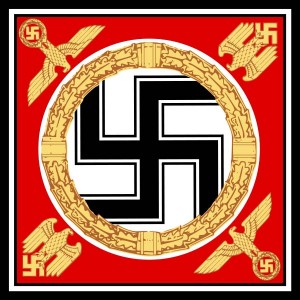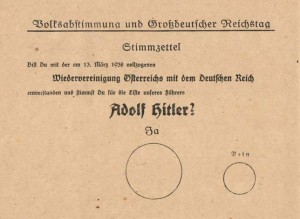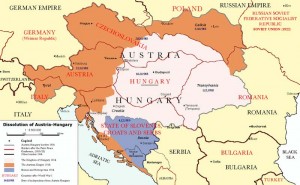 Anschluss—also known as Anschluss Österreichs—is a German word that means “union.” It refers to the political unification of Austria and Germany, which occurred in 1938. It was first proposed by Austria in 1919, and the Austrian Social Democrats pushed for it from 1919 to 1933. However, during that time the union was forbidden by both the Treaty of Versailles and the Treaty of Saint Germain.
Anschluss—also known as Anschluss Österreichs—is a German word that means “union.” It refers to the political unification of Austria and Germany, which occurred in 1938. It was first proposed by Austria in 1919, and the Austrian Social Democrats pushed for it from 1919 to 1933. However, during that time the union was forbidden by both the Treaty of Versailles and the Treaty of Saint Germain.
Before the Anschluss
In July of 1934, German Nazis and sympathetic Austrian officials took part in a failed attempt to join the two contries. On July 25th of that same year, Chancellor Dollfuss of Austria was killed in a failed coup-de-tat by Austrian Nazis. Consequently, a short civil war broke out that lasted until August of 1934. When the fighting had settled, a conservative government took control in Austria that did not agree with the Anschluss.
After the new government had been established, many of the Austrian Nazis left for Germany, where they continued to advocate for the Anschluss. The Austrian Nazis that remained began to use terrorist attacks on various Austrian government institutions, which resulted in the deaths of nearly eight hundred citizens between 1934 and 1938.
Hitler Meets With Austria’s Chancellor
On February 12th of 1938, Adolf Hitler met with Kurt von Schuschnigg, the Chancellor of Austria, at Berchtesgaden to discuss the Anschluss. Hitler gave Schuschnigg his demands, which included appointing several Austrian Nazis to powerful government positions. In accordance with this, Hitler wanted Arthur Seyss-Inquart, the Austrian Nazi leader, to be the Public Security Minister, a post that would give him total control over Austria’s police forces. Seyss-Inquart had been a Nazi for a long time and was in favor of the Anschluss.
Hitler told the Chancellor that if he agreed to the terms, he would remain committed to the Austro-German Agreement that was signed in July 1936, and reaffirm that he supported Austria’s national sovereignty. After accepting Hitler’s agreement, Schuschnigg went back to Vienna and instated the changes to Austria’s government. However, President Wilhelm Miklas of Austria, adamantly refused to appoint Seyss-Inquart as a new minister.
Some time later, Schuschnigg announced a vote on the Anschluss issue in an attempt to settle the matter democratically. However, the vote was on March 11th, when Hitler gave Schuschnigg the choice between handing over power to the National Socialists in Austria or facing a military invasion. The order expired at noon, but ended up being extended for two hours. At one o’clock, Hitler signed the military order that sent troops into Austria.
Schuschnigg tried desperately to find support for Austria’s independence after receiving Hitler’s order. But when he realized that France and Britain were not going to take action, he resigned from his position. At his resignation, he told the Austrian Army to go along with the Germans to avoid bloodshed.
German Troops Enter Austria
On the morning of March 12th, 1938, German troops crossed over the border into Austria. For the German Wehrmacht, the invasion was their first test even though no fighting actually occurred. The armed forces were welcomed by many cheering German-Austrians that gave Nazi salutes, waved Nazi flags, and handed out flowers. The annexation is also known as the “Blumenkrieg” which means the war of flowers.
Adolf Hitler arrived in Braunau, his birthplace, in the afternoon of March 12th. That evening, he appeared in Linz and was enthusiastically welcomed in the city hall. He then appointed Seyss-Inquart as the new governor Austria. Hitler annexed Austria the next day on March 13th and declared that Austria would now be a province of Ostmark. On March 15, 1938, Hitler went to Vienna and gave a speech where he talked about how Germany did not come as tyrants, but as liberators.
Hitler’s forces in Austria tried to suppress any opposition to the Anschluss. After the Anschluss was announced on March 13th, as many as seventy thousand people were arrested. Heinrich Himmler, along with his SS officers went to Vienna in order to arrest the more prominent officials in the First Republic including Leopold Figl, Richard Schmitz, Franz Olah, and Friedrich Hillegeist. During the time between the Anschluss and the vote, authorities arrested many Communists, Social Democrats, Jews, and other political dissenters, putting them in prison or sending them to concentration camps.
The Anschluss Vote
 A vote was held on April 10th of 1938, and the Anschluss was reported by the Germans to have been approved by approximately ninety-nine percent of the voters. The voters were subjected to massive amounts of propaganda and nearly four hundred thousand people, almost ten percent of the population that was eligible to vote, were not allowed to do so.
A vote was held on April 10th of 1938, and the Anschluss was reported by the Germans to have been approved by approximately ninety-nine percent of the voters. The voters were subjected to massive amounts of propaganda and nearly four hundred thousand people, almost ten percent of the population that was eligible to vote, were not allowed to do so.
After the Anschluss
After the annexation, Austria transferred all power to Nazi Germany, and thousands of Wehrmacht troops moved into Austria to maintain the Anschluss. Although the conditions of the Treaty of Saint Germain and the Treaty of Versailles strictly forbode the combination of Germany and Austria, the Allies did little to oppose it. No military action occurred and the strongest voices that opposed the Anschluss—Italy, Britain and France—did nothing to stop it.
The Anschluss was one of the first major actions that Adolf Hitler took to create the Greater German Reich. He endeavored to absorb all ethnic Germans in other contries as well as the territories that had been part of the German Empire before World War I. Although Austria had never actually been part of German Empire in the twentieth century, it was still seen as part of Germany.
After the vote, the Saar region was returned to German control after fifteen years of occupation. Following the annexation of Austria, Czechoslovakia was also targeted for absorption. This provoked an international crisis that resulted in the Munich Agreement, signed in September of 1938, which gave Germany control over the Sudetenland, whose population was mostly ethnic German. In March of 1939, Hitler ended Czechoslovakia after recognizing Slovakia as an independent state with the remainder of the region as a protectorate. Lithuania returned Memelland in the same year.
Austria was considered part of Germany until the conclusion of World War II. After the war, a preliminary government established in Austria declared the Anschluss invalid on April 27th of 1945. Allied-occupied Austria ended up being acknowledged and dealt with as a separate nation from Germany proper. The Austrian Declaration of Neutrality and the Austrian State Treaty, both formed in 1955, restored Austria’s sovereignty. This action was a result of the developments of the Cold War, along with various disputes involving the Soviet Union and its former allies.
